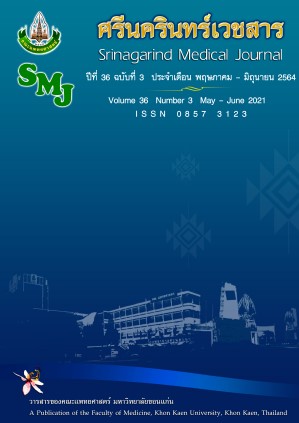ผลของการออกกำลังกายด้วยตารางเก้าช่องต่อการทรงตัวของผู้สูงอายุที่มีความเสี่ยงต่อการหกล้ม
คำสำคัญ:
ผู้สูงอายุ; การออกกำลังกาย; การทรงตัว; หกล้มบทคัดย่อ
หลักการและวัตถุประสงค์: ปัจจุบันการออกกำลังกายด้วยตารางเก้าช่องเป็นที่แพร่หลายในชุมชน แต่ผลต่อการทรงตัวของผู้สูงอายุยังไม่ชัดเจน การศึกษานี้มีวัตถุประสงค์เพื่อประเมินผลของการออกกำลังกายด้วยตารางเก้าช่องต่อการทรงตัวของผู้สูงอายุที่มีความเสี่ยงต่อการหกล้ม
วิธีการศึกษา: ผู้สูงอายุจำนวน 34 ราย (อายุเฉลี่ย 63.8±2.0 ปี) ถูกแบ่งเป็นกลุ่มทดลองและกลุ่มควบคุม (กลุ่มละ 17 ราย) กลุ่มทดลองได้รับการฝึกออกกำลังกายด้วยตารางเก้าช่อง 3 วันต่อสัปดาห์ วันละ 30 นาที เป็นเวลา 5 สัปดาห์ กลุ่มควบคุมได้รับการอบรมความรู้ในสัปดาห์ที่ 2 และ 4 ของการศึกษา ประเมินการทรงตัวขณะเคลื่อนไหวและยืนนิ่งของอาสาสมัครเมื่อก่อนและหลังการศึกษาด้วย Timed Up and Go Test (TUGT) และ One Leg Stance Test (OLST) ตามลำดับ วิเคราะห์ผลการศึกษาด้วยสถิติ T-tests
ผลการศึกษา: เมื่อสิ้นสุดการศึกษา กลุ่มทดลองมีการทรงตัวดีขึ้นอย่างมีนัยสำคัญทางสถิติ (p<0.05) และเมื่อเปรียบเทียบระหว่างกลุ่มพบว่ากลุ่มทดลองใช้เวลาในการทำ TUGT น้อยกว่ากลุ่มควบคุมอย่างมีนัยสำคัญทางสถิติ (p<0.001) แต่ผลการทำ OLST ของทั้ง 2 กลุ่มแตกต่างกันอย่างไม่มีนัยสำคัญทางสถิติ (p>0.10)
สรุป: การออกกำลังกายด้วยตารางเก้าช่องช่วยเพิ่มการทรงตัวขณะเคลื่อนไหวของผู้สูงอายุที่มีความเสี่ยงต่อการหกล้มได้ จึงอาจเป็นทางเลือกหนึ่งสำหรับการพัฒนาการทรงตัวของผู้สูงอายุในชุมชน
เอกสารอ้างอิง
2. Mahidol Population Gazette. Thailand population 2017. Bangkok: Mahidol Population Gazette, 2017.
3. Bird ML, Pittaway JK, Cuisick I, Rattray M, Ahuja K. Age-related changes in physical fall risk factors: result from a 3 year follow-up of community dwelling older adults in Tasmania, Australia. Int J Environ Res Public Health 2013; 10: 5989-5997.
4. Dhargave P, Sendhilkumar R. Prevalence of risk factors for falls among elderly people living in long-term care homes. J Clin Gerontol Geriatr 2016; 7: 99-103.
5. Jitapunkul S, Na Songkhla M, Chayovan N, Chitratkul A, Choprapawon C, Kachondham Y, et al. Fall and their associated factor: a nation survey of the Thai elderly. J Med Assoc Thai 1998; 81: 233-242.
6. Rongmuang D, Nakchattri C, Tongdee J, Sombutboon J. Incidence and factors associated with fall among the community-dwelling elderly, Suratthani. J Phrapokklao Nurs College 2016; 27: 123-138.
7. Kwon IH, Song JY, Kim DY, Son JY, Shim YJ, Shin WS. Comparison of rhythmic and non-rhythmic aerobic exercises on depression and balance in the elderly. Phys Ther Rehabil Sci 2017; 6: 146-151.
8. Silsupadol P. Exercise as an intervention for preventing falls in community-dwelling older adults. Thai J Phys Ther 2012; 4: 180-192.
9. Yardley L, Beyer N, Hauer K, McKee K, Ballinger C, Todd C. Recommendations for promoting the engagement of older people in activities to prevent falls. Qual Saf Health Care 2007; 16: 230-234.
10. Krabuanrat C. The 9-square exercise and brain development. Bangkok: Grand Sport Group, 2007.
11. Junprasert S, Toonsiri C, Chalaem T, ChooJun N, Kirdnoil P, Songprasert A, et al. Impact of nine-square Thai dancing on elderly people’s health. Thai J Nurs Coun 2013; 28: 60-80.
12. Ronnarithivichai C, Thaweeboon T, Petchpansri S, Sujijantararat R, Boonchan N, Kridiborworn C. The evaluation of physical fitness before and after 9-square-table aerobic exercise and rubber ring stretching of elders in the health promotion program for the elderly, Faculty of Nursing, Mahidol University. J Nurs Sci 2009; 27: 68-76.
13. Manunyanon S. The effect of different size of the matrix of nine square on agility for badminton [Master Thesis in Sports Science]. Bangkok: Graduate School, Kasetsart University, 2011.
14. Watchiramekakul L, Krabuanrat C, Reungthai R. Effect of specific movement training program on reaction time in taekwondo player. J Sport Sci Tech 2011; 11: 176-191.
15. Cheunsakulpong T, Abthaisong O. The effect of moving the body in the nine squares table with balance and memory in geriatric psychiatric patients who admitted in Prakaisuk ward. J Srithanya Hospita 2012; 13: 16-25.
16. Mangione KK, Craik RL, McCormick AA, Blevins HL, White MB, Sullivan-Marx EM, et al. Detectable changes in physical performance measures in elderly African Americans. Phys Ther 2010; 90: 921-627.
17. Nualnetr N, Aonsri C, Chaipipat N. A comparison of 9-square exercise and conventional balance exercise on balance in older women. Thai J Phys Ther 2016; 38: 93-102.
18. Jalayondeja C. Falls screening by Timed Up and Go (TUG). J Med Tech Phys Ther 2014; 26: 5-16.
19. Prasat Neurological Institute. Clinical practice guidelines: dementia. Bangkok: Tana Press Printing, 2014.
20. Chirawatkul A. Statistics for health science research. Bangkok: Wittayaphat, 2013.
21. Nokham R, Panuthai S, Khampolsin T. Effect of square-stepping exercise on balance among older persons. Nurs J 2016; 43: 58-68.
22. Podsiadlo D, Richardson S. The timed “Up & Go”: a test of basic functional mobility for frail elderly persons. J Am Geriatr Soc 1991; 39: 142-148.
23. Springer BA, Marin R, Cyhan T, Roberts H, Gill NW. Normative values for the unipedal stance test with eyes open and closed. J Geriatr Phys Ther 2007; 30: 8-15.
24. Bohannon RW. Responsiveness of the single-limb stance test. Gait Posture 2012; 35: 173.
25. Pescatello L, Arena R, Riebe D, Thompson P. ACSM’s guidelines for exercise testing and prescription. 9th ed. Baltimore: Lippincott Williams & Wilkins, 2014.
26. Ritchie C. Rating of perceived exertion (RPE). J Physiother 2012; 58: 62.
27. Farlie MK, Molloy E, Keating JL, Haines PT. Clinical markers of the intensity of balance challenge: observational study of older adult responses to balance tasks. Phys Ther 2016; 96: 313-323.
28. Gschwind YJ, Kressig RW, Lacroix A, Muehlbauer T, Pfenninger B, Granacher U. A best practice fall prevention exercise program to improve balance, strength/power, and psychosocial health in older adults: study protocol for a randomized controlled trial. BMC Geriatr 2013; 13: 1-13.




